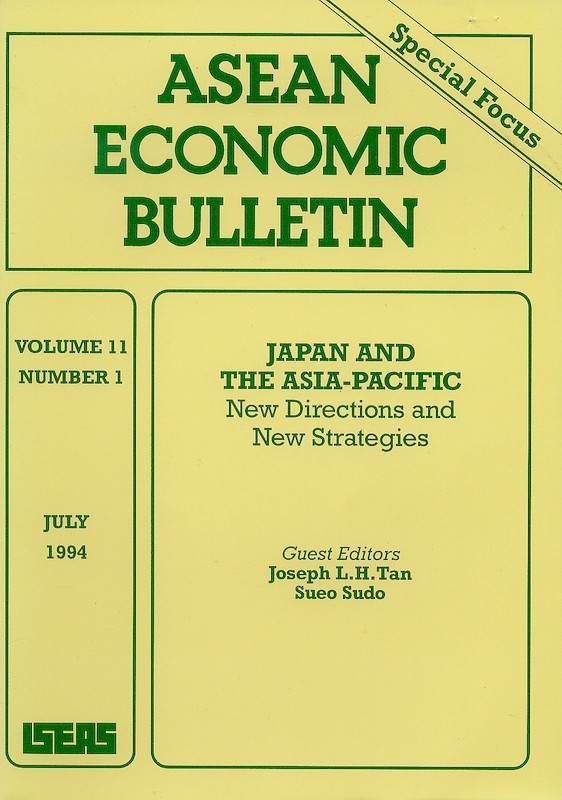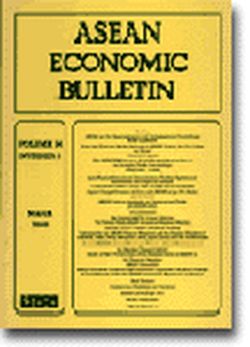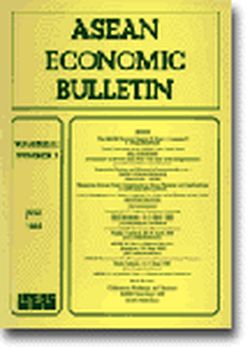ASEAN Economic Bulletin Vol. 6/3 (Mar 1990)

Date of publication:
March 1990
Number of pages:
154
Code:
AE6/3
Contents
-
Preliminary pages
- ARTICLES
-
Primary Commodities and Strategies for Development in ASEAN, by Peter N Nemetz, author see abstractDespite the rapid industrialization of the ASEAN states in the past few decades, primary commodities retain a crucial role in external trade and economic development. This paper presents a typology of coalition strategies for development through the process of economic integration. It is concluded that in light of an imperfect world, the most robust strategy for many Third World nations may be a mixed one, incorporating, with the pursuit of global free trade, complementary strategic coalitions despite the inherent efficiency-reducing effects of many of these alternatives.
-
ASEAN's Institutional Structure and Economic Co-operation, by Chng Meng Kng , author see abstractThis paper evaluates ASEAN's institutional structure and its evolution in the wider framework of ASEAN's objectives as a regional organization with a view to understanding the limits and possibilities of institutional change.
-
Australia and Indonesia: Challenges and Opportunities in a "Small" Economic Relationship, by Hal Hill, author see abstractThis paper analyses major features of and issues in Australia-Indonesia economic relations, focusing on merchandise trade, investment, services trade and aid. There is disappointment in both countries that the economic relationship is not stronger, although there are obvious reasons both related to policies and to economic structures why bilateral commerce has not expanded more rapidly. The paper also points to areas of strength in the economic relationship, and to future challenges and opportunities.
-
The State and Industrial Relations in Developing Countries: The Malaysian Situation, by Ponniah Arudsothy , author see abstractA synthetic model of the variety of industrial relations experiences is used to evaluate the types of role the state can play in the industrial relations of a group of Third World countries such as ASEAN. Such an approach avoids the uni-linear and reductionist approaches of the right and the left, which by assimilating the state to the economy, totally neglect the importance of class struggles and political "bargaining" which affects bureaucratic controls even in the most corporatist state. Thus an understanding of the dynamics of industrial relations in any country can be gained only through relating these descriptive categories to specific historical and economic contexts in the development experience of a country: no a priori explanations can be offered. This paper examines the historical influences on the Malaysian industrial relations system and discusses the current state and likely trends in industrial relations within the above framework of analysis.
-
The Effects of Tin Export Tax on Production, Export, and Prices in Malaysia, by Mohammed Bin Yusoff, author see abstractThis study shows that tin export tax results in negative impacts on production, export, and employment. The domestic producers have to bear more of the burden of export tax since the supply is less elastic than the export demand with respect to own-price. The reduction in domestic tin output as a result of export tax would mean that fewer workers would be employed in the industry. Therefore, it is suggested that the tin export tax be reduced substantially to prevent more miners from leaving the industry and reduce the unemployment problem. The study also indicates that Malaysian producers of tin tend to over produce when there is an increase in the demand for tin due to an increase in the number of mines, the price of aluminium, and the world production index. This suggests that tin producers should also pay more attention towards production planning so that the excess supply of tin could be reduced to prevent the tin price from falling.
-
Human Resource, Factor Intensity, and Export Structure of Singapore and Malaysia, by Anis Chowdhury , C H Kirkpatrick, authors see abstractThe paper examines the impact of rising human resource (HR) endowments on the relative factor intensity and composition of manufactured exports of Singapore and Malaysia. Following the traditional approach, relative factor intensities are approximated by wage and non-wage value added per employee. The findings show that the manufacturing activities in both countries have become more HR intensive. While in Singapore, the HR upgrading has accompanied substantial upgrading of capital equipment, a wedge between the skill and capital upgrading appears to have developed in Malaysia. This seemingly peculiar phenomenon in Malaysia may have been due to the dominance of electronics assembling which is very capital intensive but requires little skill. As far as export composition is concerned, it has become more HR oriented in Singapore as a result of the rise in the export shares (export structure effect) of those activities which have become more HR intensive (industry effect). But in the case of Malaysia, the export structure is dominated by electronics whose assembly is not HR intensive. As a result, Malaysia's manufactured exports have remained less HR oriented.
-
BOOK REVIEW: The Development Crisis: Blueprint for Change, by Carlos Geraldo Langoni, by James W Dean, author
-
BOOK REVIEW: How to End Up an Utter Failure as Minister of the Economy: Lessons That Emerge from 20 Years of Argentine Economic Policy, by Juan Carlos de Pablo; Some Problems in Implementing Economic Policy, by Jesus Silva-Herzog, by Hans Christoph Rieger, author
-
BOOK REVIEW: China: External Trade and Capital. A World Bank Country Study., by Dieter Bender, author
-
BOOK REVIEW: One Partnership in Development: UNDP and Singapore, by Chow Kit Boey, Chew Moh Leen, and Elisabeth Su, by Judith Jutte-Rauhut, Werner Gocht, authors
-
DOCUMENTATION: Asia Pacific Economic Cooperation, Ministerial-Level Meeting, Joint Statement, 6-7 November 1989, Canberra
-
DOCUMENTATION: Asia Pacific Economic Cooperation, Ministerial-Level Meeting, Summary Statement by the Chairman, Senator the Hon. Gareth Evans QC, Minister for Foreign Affairs and Trade of Australia, 7 November 1989, Canberra
-
DOCUMENTATION: Joint Statement of the 21st Meeting of the ASEAN Economic Ministers (AEM), 30 November-1 December 1989, Brunei Darussalam
-
Conferences, Workshops, and Seminars
-
ASEAN Chronology 1989
-
Some Recent Publications
-
Index to Volume 6





